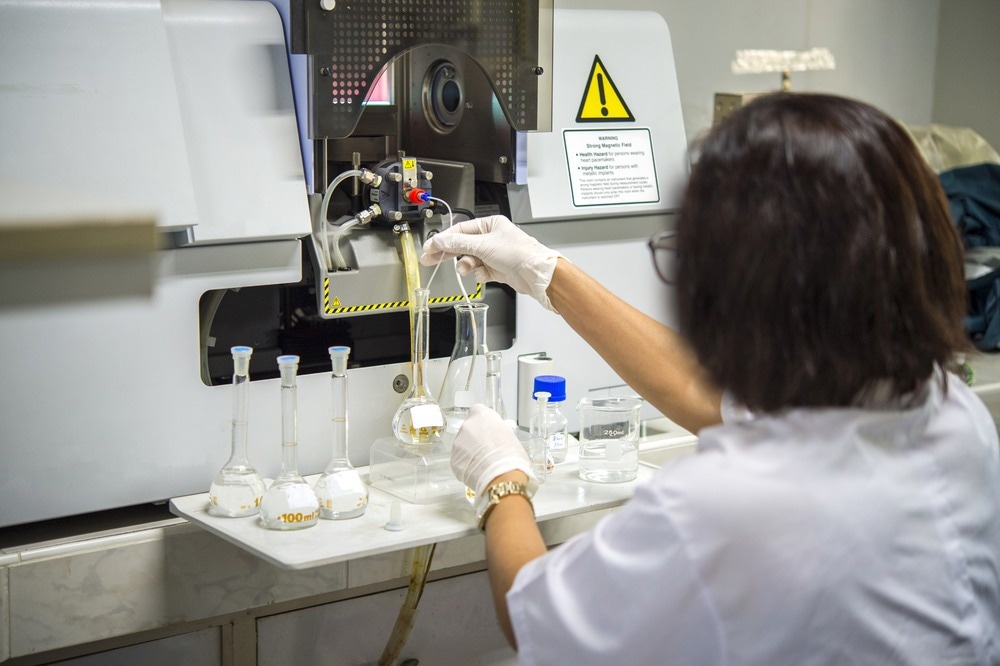A recent article published in ACS Photonics demonstrates an on-chip array spectrometer that can simultaneously acquire high-resolution bands using optical Fabry-Perot cavities and a broad spectral range with adjustable optical filters.

Study: Broadband and High-Resolution Integrated Spectrometer Based on a Tunable FSR-Free Optical Filter Array. Image Credit: Rabbitmindphoto/Shutterstock.com
Integrated spectrometers facilitate portable, low-cost spectroscopic sensing, which plays a vital role in the lab-on-a-chip system. However, developing a high-resolution portable spectrometer across a wide wavelength range is challenging, utilizing current on-chip designs.
Potential Applications of On-Chip Spectrometer
Spectrometers provide potential in several domains, including biological sensing, materials characterization, multispectral scanning, and light source analysis.
Developing a high-performance on-chip spectrometer is promising for enabling real-time content analysis, persistent monitoring systems, and extensive agricultural monitoring.
Fourier Transform Spectrometers (FTSs)
Fourier transform spectrometers (FTSs) can offer a greater signal-to-noise ratio than typically integrated spectrometers owing to the higher acquired optical power.
The FTS approach works by varying the optical path length inside a spectrometer to create a time-domain interference pattern of the input signal, which is then proceeded by a Fourier transform to reconstruct the optical spectrum.
The FTSs have several disadvantages, including a high power requirement, a high driving potential, a prolonged measuring period, and a substantial footprint.
Reconstructive Spectrometers
Reconstructive spectrometers have emerged during the last decade. Using computational methods, such instruments employ dispersion media to construct a distinctive fingerprint for each input signal wavelength.
Device footprint and channel capacity can be drastically lowered for sparse spectra. Developing a sequence of speckles with an optimum orthogonal spectrum response and reducing scattering loss inside the scattering medium are the two key problems for the reconstructive spectrometer. Furthermore, greater processing power is required for the application to analyze complicated spectra.
Limitations of Current Integrated Spectrometers
Integrated spectrometers segregate the optical spectrum of the input signals into photodetectors using diffraction optics or narrowband filters. The length of the optical path constrains the spectral resolution of diffraction optic-based on-chip spectrometers. The spectral resolution is inversely proportional to the length of the optical path.
Optical channels and high-performance photo-detectors are required to achieve wide spectrum bandwidth and excellent spectral resolution, resulting in a significantly large footprint, manufacturing constraints, and operating complexity.
Narrowband filters that choose a specific wavelength of light enable on-chip spectrometers to be more compact. The high spectral resolution can be attained by inserting several filters with close channel spacing. However, the wide spectral range significantly restricts the spectral bandwidth.
Integrated spectrometers face another challenge of inevitable fabrication imperfections for the large-scale filter array, which is crucial for small channel spacing.
Development of Optical Filter-based Spectrometer
Sun et al. developed a compact, high-resolution, and broadband integrated spectrometer using optical filters to overcome the limitations of conventional integrated spectrometers. A tunable optical filter that overcomes the spectral range constraint is a critical component in integrated spectrometer development.
The optical filters can channel all wavelengths as they are all constructed initially with the same optimum wavelength spacing. Using silicon's large thermo-optical coefficient, one can achieve a wide variety of adjustable spectrum frequencies.
Stacking several optical filters can result in a wide spectral range. The researchers used the filter with a double-side-coupled cavity to achieve FSR-free performance with restricted bandwidth.
The operating complexity of the spectrometer was reduced by using a single heater for uniform adjustment of all the filters. The optical filter spectrometer demonstrated easy scaling and a flexible setup over a wider spectrum range by configuring the filters to accommodate a range of preferred and even individual wavelength bands.
Benefits of an Optical Filter-Based Spectrometer
Using a tunable FSR-free optical filter array, the researchers developed and demonstrated a compact, integrated spectrometer with high resolution and a wide spectrum range. Each optical filter unit using tunable components significantly decreases the number of physical channels.
The resolution of the tuneable optical filter-based spectrometer increases compared to the standard narrow-filter-based spectrometer by accurately adjusting the resonance wavelength. The optical filter's FSR-free functioning eliminates the spectral range constraint.
Five-channel and seven-channel spectrometers were constructed as models and experimentally evaluated by Sun et al. The models showed resolutions of 0.43 and 0.51 nm and a spectral range of 73.2 and 102.7 nm, respectively.
By incorporating isolating trenches, the power consumption resulting from thermal tuning can be significantly decreased. By stacking a series of filters that cover necessary or even specific bands, the optical filter-based spectrometer can be adjusted flexibly, expanded to a wider spectrum range, and scaled effectively.
Reference
Sun, C., Chen, Z., Yin, Y., Ye, Y., Luo, Y., Ma, H., Jian, J., Shi, Y., Zhong, C., Zhang, D., Lin, H., & Li, L. (2022). Broadband and High-Resolution Integrated Spectrometer Based on a Tunable FSR-Free Optical Filter Array. ACS Photonics. https://pubs.acs.org/doi/10.1021/acsphotonics.2c00538
Disclaimer: The views expressed here are those of the author expressed in their private capacity and do not necessarily represent the views of AZoM.com Limited T/A AZoNetwork the owner and operator of this website. This disclaimer forms part of the Terms and conditions of use of this website.